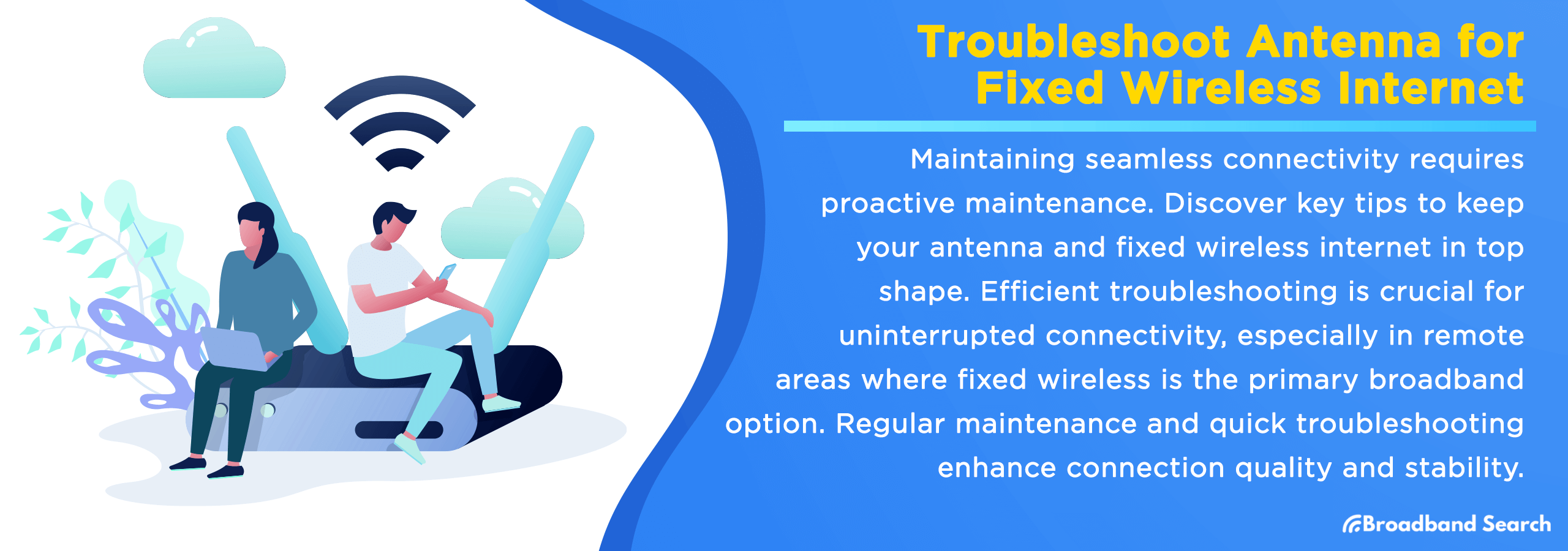Fixed wireless internet provides broadband access through radio waves, eliminating the need for telephone or cable lines. Central to this system is the antenna which receives and transmits signals to and from a nearby wireless base station. The efficiency and reliability of fixed wireless internet heavily depend on the optimal functioning of these antennas.
Effective troubleshooting of antennas is essential to maintaining robust connectivity. Understanding common issues and how to address them ensures uninterrupted internet service. This is especially crucial in remote or rural areas where fixed wireless internet is often the primary or only source of broadband access. Regular maintenance and prompt troubleshooting can significantly enhance the quality and stability of the connection.
Common Antenna Problems
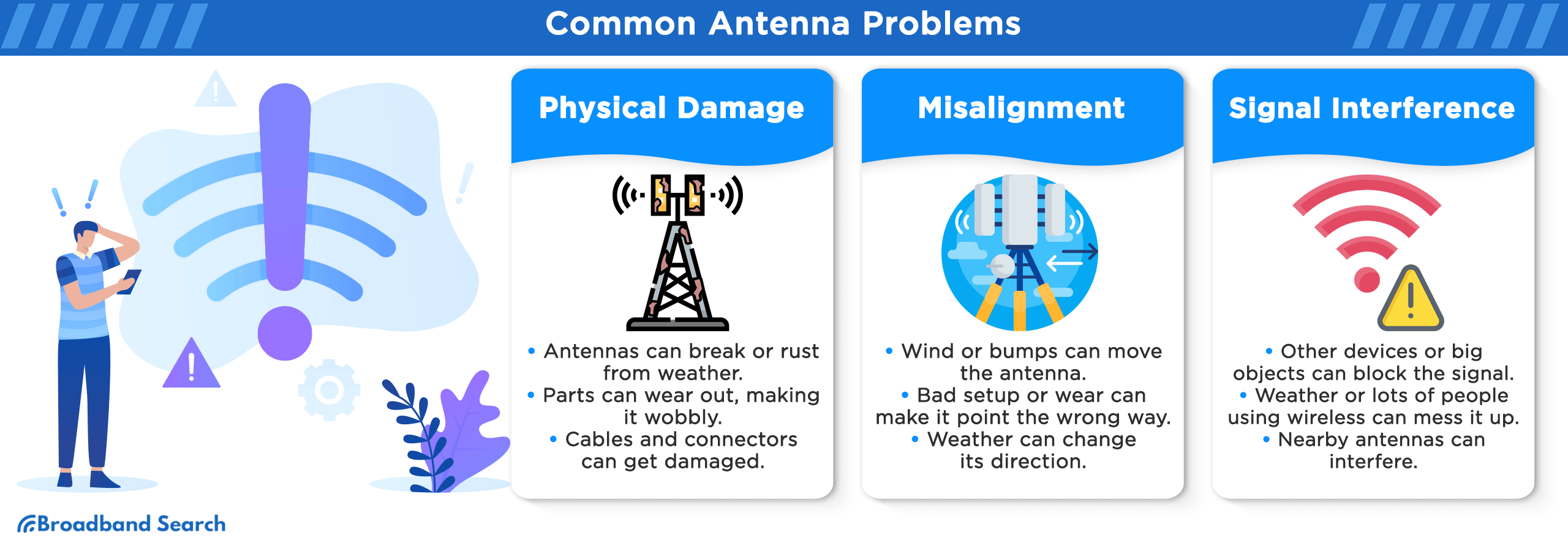
Antennas experience issues that can disrupt fixed wireless internet connectivity. These problems range from structural damage caused by external forces to gradual degradation due to environmental exposure. Identifying and addressing these issues is crucial for maintaining a stable and efficient internet connection.
Physical Damage
- Structural Damage to the Antenna: Physical impairments such as cracks, bends, or breaks in the antenna structure can drastically affect its performance. These damages can result from environmental factors like harsh weather or accidental impacts.
- Corrosion and Rust: Exposure to moisture and varying weather conditions can lead to rust and corrosion, particularly in metallic parts of the antenna. This deterioration compromises the antenna's integrity and functionality.
- Wear and Tear of Mounting Equipment: The mounting brackets, screws, and other support structures can undergo wear and tear over time. This can lead to loosening or weakening of the antenna's support, affecting its stability and alignment.
- Cable Damage: The cables connecting the antenna to other equipment are prone to damage from external elements, such as UV exposure, animals, or physical strain. Damaged cables can result in poor signal transmission.
- Connector and Port Damage: Connectors and ports are essential for the interface between the antenna and the transmission equipment. Damage to these components, such as bending, breaking, or corrosion, can lead to poor or lost connections.
Misalignment
- Strong Winds: High winds are a common cause of antenna misalignment. They can physically move the antenna, especially if the mounting is not secure or has weakened over time. This misalignment can result in a weaker signal or even complete loss of reception until conditions improve and the antenna is realigned.
- Improper Installation: Incorrect setup or insecure mounting during installation is another major factor. Misalignments from improper installation can either be immediate or develop gradually. Ensure that antennas are installed correctly, according to specifications, for optimal performance.
- Physical Impacts: Antennas can be displaced from their optimal positions due to accidental impacts from objects or animals. Even minor impacts can shift the antenna enough to affect signal quality. A study focused on RF antennas in 4G/LTE networks demonstrated that even slight misalignments in the antenna's azimuth and mechanical tilt can lead to notable reductions in data throughput.
- Vibration and Movement: Nearby vibrations from machinery, heavy traffic, or building movements can cause gradual shifts in the antenna's position. Over time, these small movements can accumulate, leading to significant misalignment.
- Weather-Related Changes: Weather conditions such as rain, temperature fluctuations, and other environmental factors can affect antennas. For instance, heavy rain can absorb or scatter broadcasting signals, leading to weaker signals. Temperature fluctuations can cause expansion and contraction of antenna components, potentially leading to loose connections.
- Aging and Wear: Over time, the components of an antenna, such as bolts and brackets, can deteriorate or corrode. This deterioration can lead to a loss of structural integrity and, consequently, misalignment.
Signal Interference
- Other Electronic Devices: Devices emitting radio frequencies can disrupt signal reception. This includes Wi-Fi routers, cordless phones, baby monitors, microwave ovens, and even fluorescent lights, which can emit electromagnetic interference affecting the TV signal.
- Large Obstacles: Physical barriers like buildings, trees, hills, or even large buildings with mirrored exteriors can block or weaken the signal path. These obstructions can reflect signals, creating multipath interference, where signals arrive at the antenna out of phase.
- Atmospheric Conditions: Weather phenomena like heavy rain, snow, dense fog, and even large temperature swings can interfere with signal transmission. High-pressure conditions on hot and cold days can cause radio signals to skip along layers of air, interfering with reception. Severe weather events like thunderstorms can also disrupt signals.
- Wireless Network Congestion: High traffic on nearby wireless networks, particularly in densely populated areas, can lead to interference. This is due to the overlapping of frequencies used by different networks.
- Interfering Signals from Other Antennas: Nearby antennas operating on similar frequencies like cell phone towers can cause significant signal interference. This is particularly true in areas with a high density of antennas or where multiple antennas are deployed in close proximity. The overlapping or close proximity of operating frequencies can disrupt the reception and clarity of the intended signal.
Step-by-Step Troubleshooting Guide
Initial Assessment
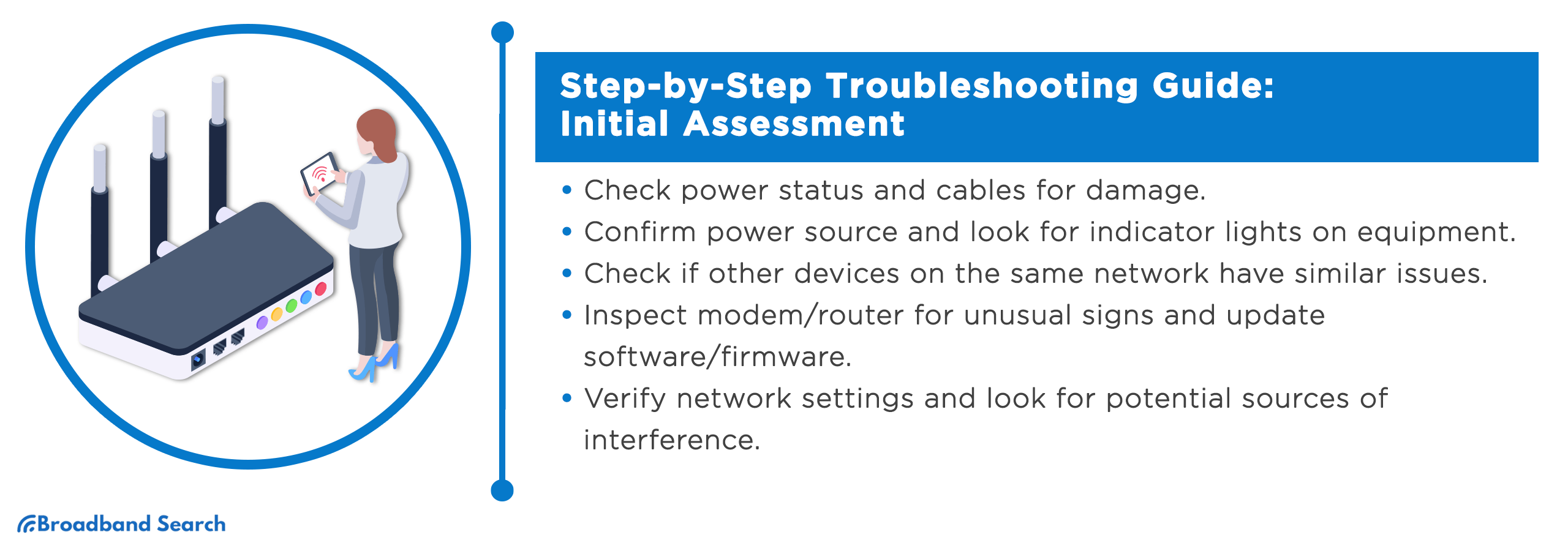
Verify Power Supply
- Check Power Status: Locate the power source for your antenna and related equipment (modem, router). Ensure that all equipment is plugged in and the power switches are in the 'on' position.
- Inspect Power Cables: Examine the power cables for any visible damage, such as cuts, fraying, or exposed wires. Check the connection points where the power cables plug into the equipment and power source. Ensure they are firmly connected and not loose.
- Power Source Check: Confirm that the power source (like a wall outlet) is operational. This can be done by plugging in another device to see if it receives power.
- Indicator Lights Check: Look for indicator lights on the equipment. Most antennas, modems, or routers have power status LEDs. A lack of lighting or unusual color might indicate a power issue.
Ensuring the Issue is with the Antenna
- Check Other Devices: Verify if other devices connected to the same network are experiencing similar issues. If all devices are affected, the issue is likely with the antenna or network. If only one device is affected, the problem may be with that specific device.
- Inspect Modem/Router: Examine your modem and router. If these devices show any unusual signs (like unusual LED behavior or no power), the problem might not be with the antenna. Resetting or troubleshooting these devices might be necessary.
- Software and Firmware Check: Ensure that your device's software and the firmware on your modem/router are up to date. Outdated software can cause connectivity issues.
- Network Settings Verification: Check the network settings on your device. Incorrect settings can lead to connectivity problems. Make sure the device is set to connect to the correct network and that any necessary passwords are correctly entered.
- Interference Check: Look around for potential sources of interference. Other electronic devices, metal objects, or thick walls between your device and the antenna can affect signal quality.
Physical Inspection
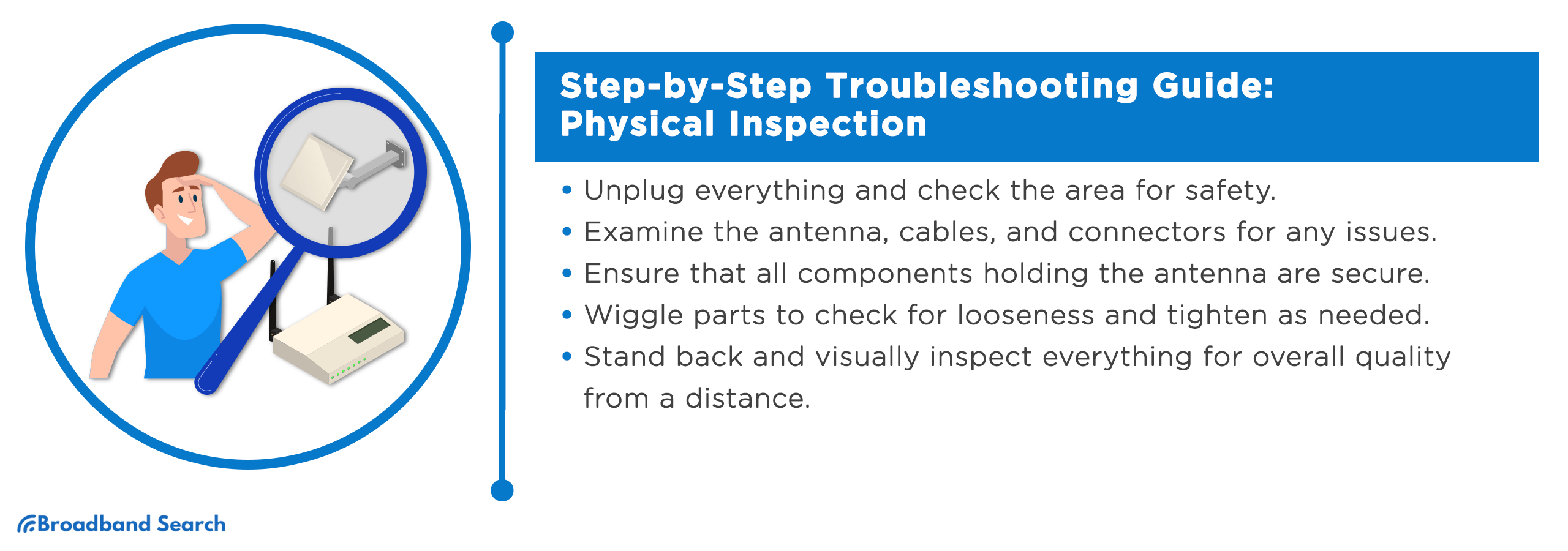
Safety Precautions
- Disconnect Power Supply: Begin by unplugging all devices from power sources, including the antenna, modem, and router. This step is crucial to avoid electric shocks and ensure safety during the physical inspection.
- Inspect the Surrounding Area: Make sure the area around your antenna and related equipment is dry and free of obstructions. Avoid performing checks in adverse weather, especially if the antenna is located outdoors.
Inspect for Visible Damage
- Antenna Inspection: Visually inspect the antenna for any signs of physical damage. Look for cracks, bends, rust, or breakage. If the antenna is mounted outside, check if it's still correctly positioned and hasn’t been dislodged or moved.
- Cable and Connector Inspection: Carefully examine all cables running to and from the antenna. Look for cuts, breaks, or damage to the cable insulation. Check connectors at each end of the cables for damage. They should be securely attached, not loose or corroded.
- Mounting Hardware Check: Ensure that mounting brackets, screws, and any other supporting hardware are intact and have not loosened over time.
- Environmental Assessment: Assess if environmental factors (like recent storms, heavy winds, or construction) could have impacted the antenna or its installation.
Check for Structural Damage
- Visual Inspection: Start by visually inspecting the entire length of the antenna. Look for any obvious bends, fractures, or deformations in the structure.
- Check for Subtle Damage: Pay close attention to joints and connections where small cracks or fractures might not be immediately apparent. Gently apply pressure with your hand to test for weak spots or hidden damage.
- Examine Antenna Surface: Look for rust, corrosion, or discoloration which can indicate underlying structural issues.
- Assess Antenna Alignment: Verify that the antenna is properly aligned according to manufacturer specifications.
Inspect Mounting Hardware
- Check Bracket Stability: Examine the mounting brackets to ensure they are firmly attached to the surface. Check for any rust or corrosion on the bracket that could compromise its strength.
- Tighten Screws and Bolts: Use appropriate tools to tighten any loose screws or bolts. If any hardware is missing, replace it immediately with compatible parts.
- Inspect Pole and Mount Integrity: Ensure that the pole or mount holding the antenna is straight and secure. Look for any signs of bending or damage to the pole.
Look for Loose Components
- Identify Loose Parts: Gently wiggle individual components of the antenna to check for looseness. Pay special attention to the points where the antenna elements connect to the base.
- Tighten Connectors: Tighten any loose connectors or cables using appropriate tools. Ensure not to overtighten, as this can cause damage.
- Securing Cables: Check that all cables are securely attached and not hanging loose. Use cable ties or clamps if necessary to secure the cables to the antenna or pole, avoiding any strain on the connections.
- Final Assessment: After making adjustments, step back and examine the antenna from a distance to ensure it looks correctly installed and aligned.
Signal Strength Testing
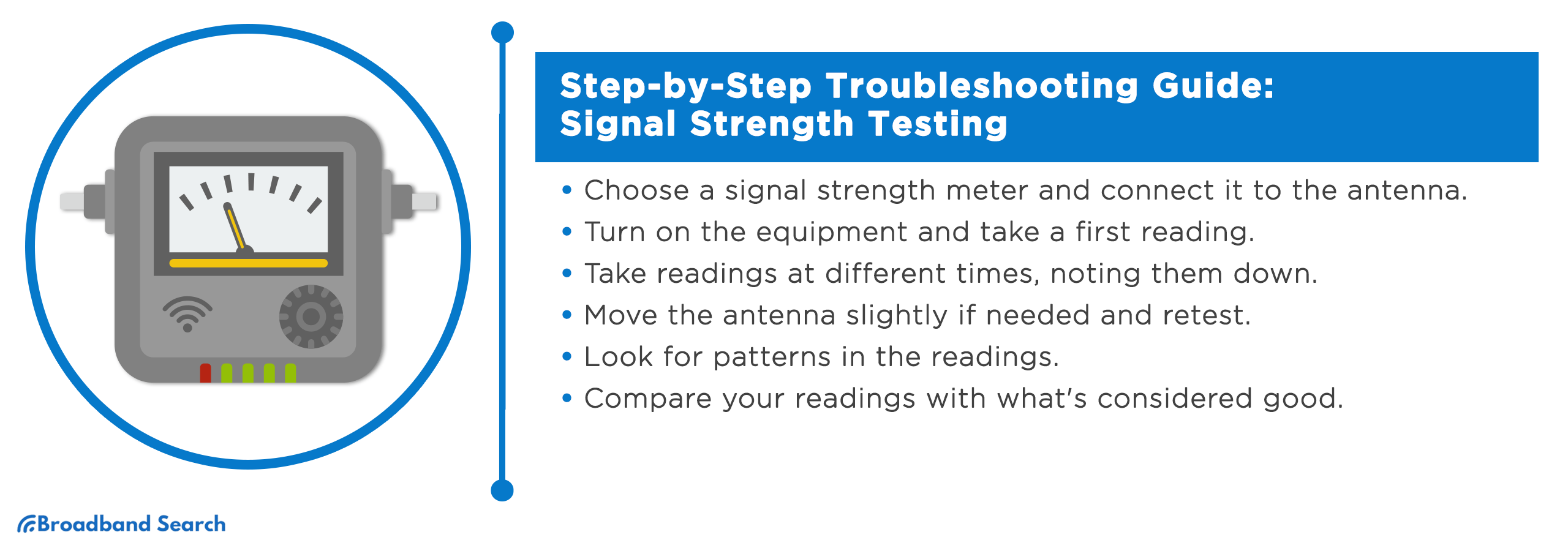
Set Up Testing Equipment
- Select a Signal Strength Meter: Choose a suitable signal strength meter or similar device compatible with your antenna system. There are various meters available, including those specifically designed for fixed wireless internet antennas.
- Connect the Meter: Connect the signal strength meter to your antenna. This is typically done by attaching the meter to the cable coming from the antenna. Refer to the meter's manual for specific connection instructions.
- Power On the Equipment: Turn on the signal strength meter. Ensure that both the meter and the antenna system (if it requires power) are operational.
- Initial Reading: Take an initial reading to get a baseline signal strength. Note this value for comparison purposes.
- Position for Testing: Position yourself in a location where you can safely access the antenna and adjust it if necessary during testing.
Record Signal Strength Readings
- Take Multiple Readings: Record signal strength readings at various times of the day. Signal strength can vary due to network congestion, atmospheric conditions, or other environmental factors.
- Document Readings: Keep a log of the signal strength readings, noting the time, weather conditions, and any other relevant observations.
- Adjust Antenna and Retest: If initial readings are lower than expected, adjust the antenna's position slightly. After each adjustment, take another reading to see if there's an improvement.
- Analyze Variations: Look for patterns in the signal strength readings. Consistent low readings might indicate an issue with the antenna or its alignment, while fluctuating readings could suggest environmental interference.
- Compare with Known Values: Compare your readings with known good values or benchmarks (which might be available from the antenna manufacturer or your internet service provider) to assess whether the signal strength is within an acceptable range.
Identifying and Resolving Interference
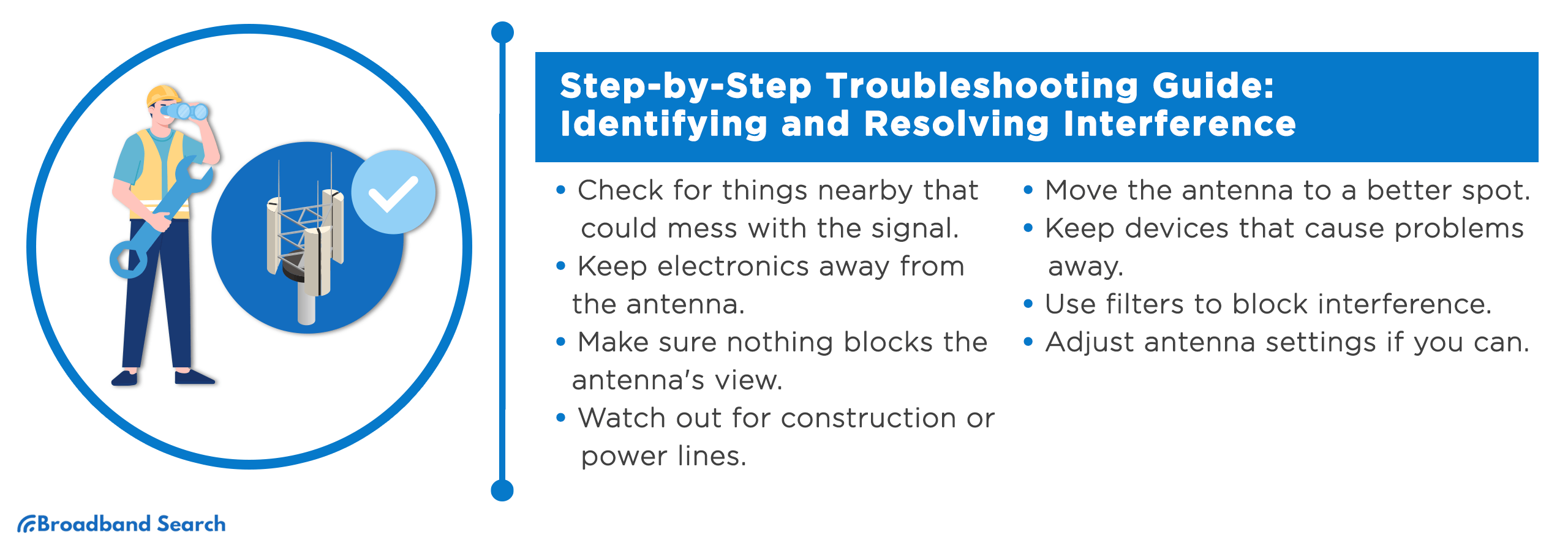
Scan for Interference Sources
- Survey the Environment: Inspect the area around the antenna for potential sources of interference, such as household electronic devices, large metal objects, or other wireless equipment.
- Identify Electronic Interference: Look for electronic devices known to cause interference, like cordless phones, microwave ovens, Wi-Fi routers, and LED lighting systems.
- Check for Physical Obstructions: Examine the line of sight from your antenna to the signal source. Obstacles like tall buildings, trees, or dense construction materials can impede signal strength.
- Monitor for External Factors: Be aware of external factors that could cause intermittent interference, such as nearby construction, power lines, or cell towers.
Implement Interference Solutions
- Relocate the Antenna: If possible, move the antenna to a higher or more open position where it's less likely to be affected by obstructions or electronic interference.
- Reposition Electronic Devices: Move potential sources of electronic interference away from the antenna and cables.
- Use Interference Filters: Install filters, such as LTE or FM filters, to block specific types of interference from cell towers or radio stations.
- Adjust Antenna Settings: Tweak the settings of your antenna system if it allows for adjustments. This might involve changing the direction of polarization to minimize interference.
Connectivity Testing
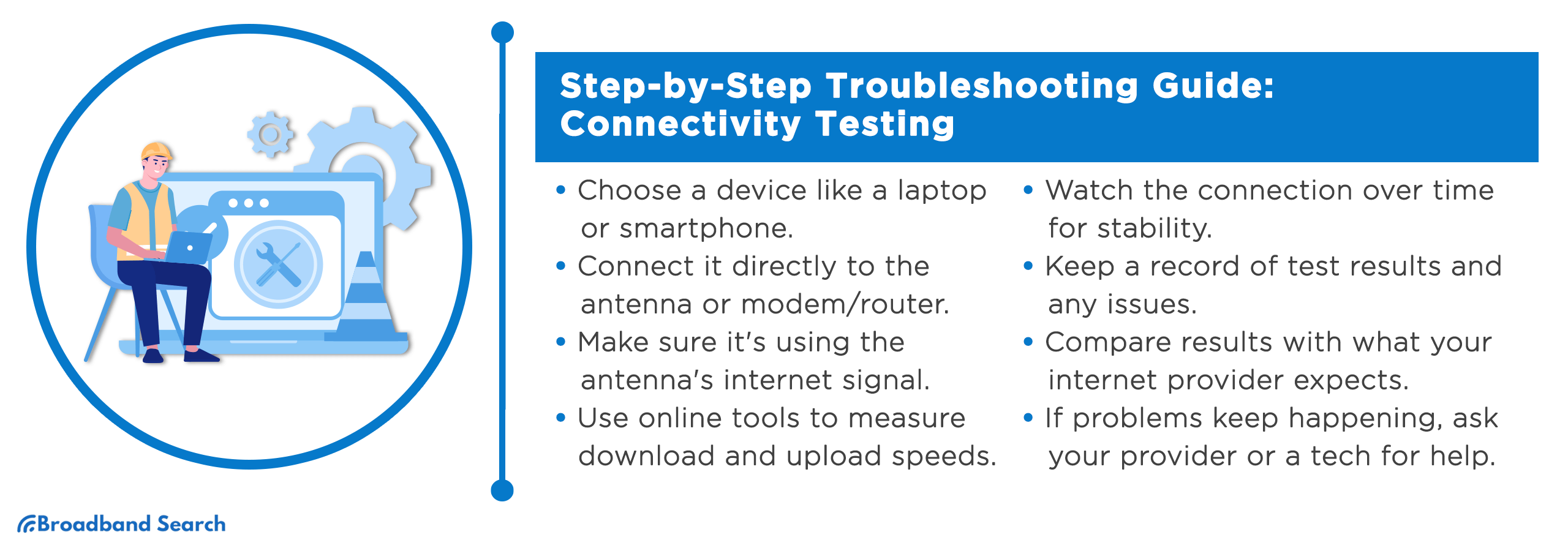
Connect a Test Device
- Select a Test Device: Choose a device such as a laptop, smartphone, or a specialized network testing tool for assessing internet connectivity.
- Direct Connection: Connect the device directly to the antenna system or the modem/router connected to the antenna. Use a wired connection if possible for more accurate results. External antennas are more efficient in capturing and transmitting wireless signals than built-in router antennas, thereby providing a stronger and more reliable Wi-Fi signal across different areas of your home or office.
- Verify Connection: Ensure the device is receiving the internet signal from the antenna and not from any other source, like Wi-Fi or a cellular network.
Conduct Speed and Stability Tests
- Perform Speed Tests: Use online speed test tools to measure the download and upload speeds. This gives you an idea of the performance level of your antenna's internet connection.
- Monitor Stability: Observe the connection over a period of time. Look for any drops in connectivity or fluctuations in speed, which could indicate stability. Use network monitoring tools like OpManager if available to track the consistency of the internet connection.
- Record and Analyze Data: Keep a log of the speed test results and any instances of connectivity loss or significant fluctuation. Analyze the data to identify patterns or specific times when the connection is less stable.
- Consult ISP for Benchmark Comparisons: Compare your test results with the benchmarks or expected speeds provided by your internet service provider (ISP). This can help determine if the issue is with the antenna setup or the service itself.
- Seek Professional Advice if Necessary: If persistent issues are noted and self-troubleshooting doesn’t resolve them, consider contacting your ISP or a professional technician for further assistance.
Technical Considerations
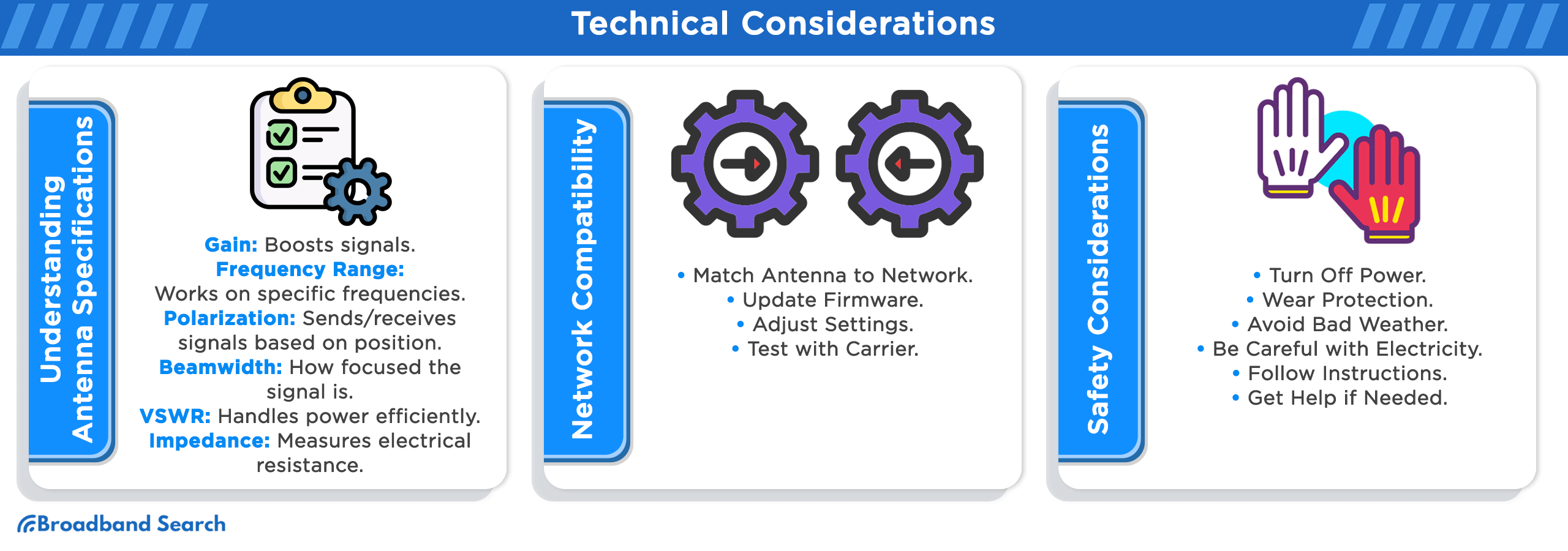
Understanding Antenna Specifications
- Gain: The gain of an antenna measures its ability to direct or amplify signal power in a specific direction. Typically expressed in decibels (dB), this determines how well an antenna can enhance signal strength, especially in targeted directions.
- Frequency Range: This refers to the range of frequencies over which the antenna can effectively operate. It's essential for ensuring compatibility with specific wireless standards and bands. The correct frequency range ensures the antenna can properly receive and transmit signals within the designated spectrum.
- Polarization: Polarization describes the orientation of the electric field of the radio wave. Antennas can be polarized vertically, horizontally, or circularly, affecting how they receive or transmit signals. The choice of polarization impacts the antenna's performance in different environments and applications.
- Beamwidth: Refers to the angular width of the radio wave beam, measured in degrees. It describes how focused the signal is; a narrow beamwidth means a more focused signal, useful for long-distance communication, while a wider beamwidth covers a broader area.
- VSWR (Voltage Standing Wave Ratio): VSWR is an indicator of the efficiency of power transmission from the antenna. A lower VSWR means better impedance and more is effectively radiated, which is desirable for efficient transmission.
- Impedance: Impedance is the measure of resistance of the antenna to the electrical current, typically standardized at 50 ohms for most wireless applications. To minimize signal loss, proper impedance matching between the antenna and the transmitter is a must. Impedance matching in RF systems is vital for ensuring optimal performance and reliability. It enables efficient power transfer, minimizes signal reflections, and enhances the overall system performance.
Network Compatibility
- Match Antenna Specifications with Network Requirements: It's crucial to inquire with your service provider about their network's capacity and the specific strategies they have implemented to ensure consistent and reliable internet speeds throughout the day and night. This inquiry will help you understand the network's ability to handle peak and off-peak traffic and maintain stable connectivity under various conditions.
- Firmware and Software Updates: Keep the antenna’s firmware and any related software up-to-date to maintain compatibility with the latest network protocols. This often includes performance enhancements and security updates that are crucial for optimal functioning within modern network infrastructures.
- Adjusting Antenna Settings: Adjust the antenna settings such as frequency, gain, and beamwidth in accordance with the recommendations of the service provider. Proper tuning ensures that the antenna is optimized for the best possible performance on the specific network.
- Test for Carrier Compatibility: Conduct tests to verify that the antenna communicates effectively with the network carrier. This testing is crucial to confirm seamless connectivity and identify any compatibility issues that might affect performance.
Safety Considerations
- Power Off Equipment Before Inspection: Before conducting any physical inspection or maintenance on your antenna and associated equipment, ensure all power sources are turned off. This is a critical safety step to prevent any risk of electrical shock or short-circuiting during the inspection process.
- Use Proper Protective Gear: When working with antennas, especially in situations involving heights or electrical components, wearing the appropriate safety gear is crucial. This includes gloves for handling equipment and eye protection to safeguard against any unforeseen accidents.
- Avoid Working in Adverse Weather Conditions: For your safety, avoid performing antenna repairs or adjustments during inclement weather conditions. High winds, rain, and lightning pose significant risks, particularly when working at heights or with outdoor antennas.
- Beware of Electrical Safety: Exercise caution when handling cables and connectors. Use a multimeter to check for live currents before touching any wires. Understanding and respecting electrical safety is paramount to prevent shock or accidents.
- Follow Manufacturer’s Instructions: Always refer to and follow the manufacturer’s instructions for your specific antenna model. These guidelines provide essential information on safe handling, installation, and troubleshooting procedures tailored to your equipment.
- Seek Professional Assistance for Complex Issues: If you encounter complex issues, especially those involving sophisticated electrical systems or work at significant heights, it’s advisable to seek professional assistance. A qualified technician can ensure the safety and effectiveness of the troubleshooting and maintenance process, reducing the risk of accidents and ensuring that complex problems are resolved correctly.
Maintenance Tips
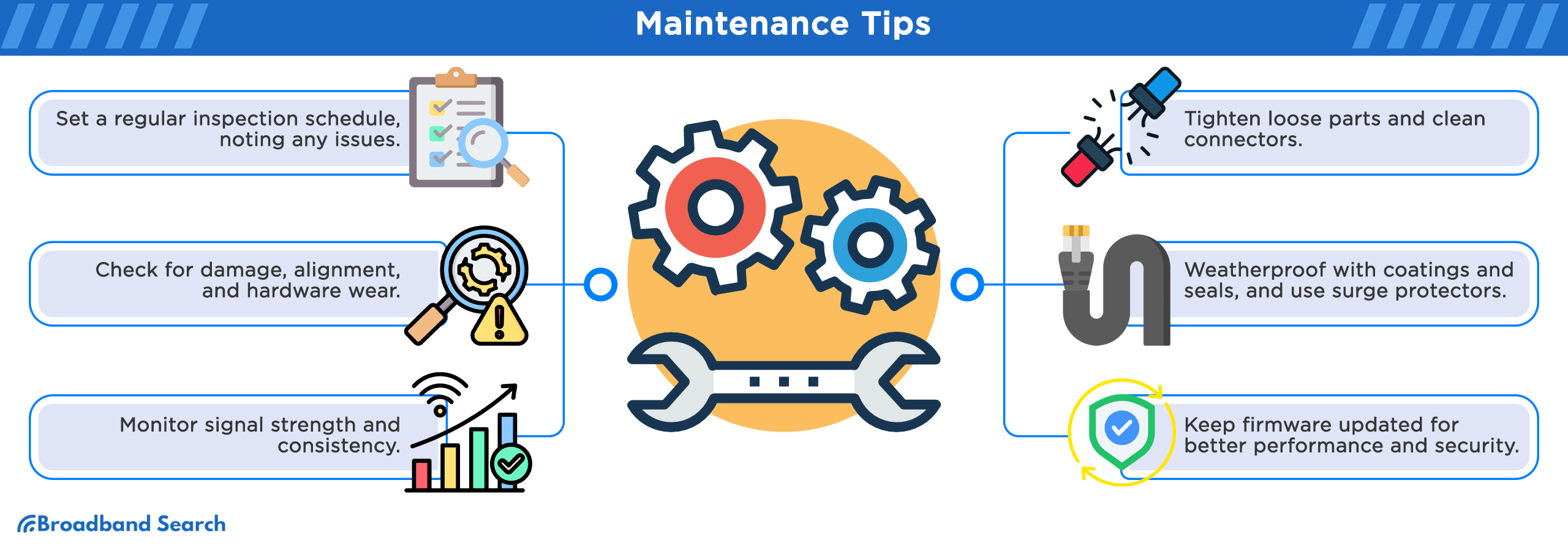
Regular Inspection
Establish a Routine Inspection Schedule
- Create a Calendar: Set up a calendar for regular antenna inspections. Monthly or quarterly intervals are recommended, depending on the environment and usage.
- Set Reminders: Use digital reminders or alarms to ensure you don't miss scheduled inspection dates.
- Document Inspections: Keep a log of each inspection, noting any issues found and actions taken. This history can be valuable for troubleshooting future problems.
Physical and Structural Checks
- Visual Inspection: Regularly examine the antenna for visible signs of physical damage, such as cracks, rust, or bent components.
- Alignment Check: Ensure the antenna is properly aligned. Misalignment can occur due to environmental factors like strong winds or physical impacts.
- Check for Wear and Tear: Inspect mounting brackets, screws, and other hardware for signs of wear, corrosion, or loosening.
Signal Quality Monitoring
- Use a Signal Meter: Periodically measure the antenna's signal strength using a signal meter or a built-in feature if available.
- Monitor Signal Consistency: Keep track of signal strength over time to identify any significant fluctuations that could indicate emerging issues.
- Record Signal Data: Maintain a record of signal quality data for comparison over time, which can help in early detection of problems.
Preventive Measures
- Tighten Loose Components: Regularly tighten any loose screws or components on the antenna and mounting hardware.
- Clean Connectors and Ports: Clean connectors and ports to ensure good electrical contact. Remove any dust, debris, or signs of corrosion.
- Adjust Orientation: Verify and adjust the antenna's orientation to ensure it is correctly positioned for optimal reception.
Weatherproofing
Apply Protective Coatings
- Choose the Right Material: Select weather-resistant paints or heat-resistant sprays specifically designed for outdoor antennas and metal structures.
- Apply Coating: Clean the antenna surface and apply the coating evenly, following the product's instructions. Allow sufficient drying time.
- Reapply as Needed: Monitor the condition of the coating and reapply periodically to maintain protection.
Secure and Seal Connections
- Inspect All Connections: Check every connection point for potential exposure to moisture and dust. Look for any signs of wear or damage to the cables and connectors.
- Seal Connections: Use waterproof sealants or weatherproofing tape to seal connections and prevent moisture ingress. Ensure seals are tight but avoid over-tightening, which can damage the connectors.
- Regularly Recheck: Periodically re-inspect and reseal connections, especially after severe weather events.
Install Surge Protectors
- Choose Appropriate Surge Protectors: Select surge protectors specifically designed for antenna systems, considering factors like clamping voltage and joule rating.
- Proper Installation: Install surge protectors as close to the equipment as possible and follow the manufacturer’s installation guidelines. Ground the surge protector correctly to ensure effectiveness.
- Regular Testing: Regularly test the surge protectors to ensure they are functioning properly.
Importance of Weatherproofing
Weatherproofing is crucial for maintaining the antenna's signal quality and prolonging its lifespan. It protects the antenna from environmental elements like rain, snow, and UV exposure, which can cause deterioration and signal degradation over time.
Firmware Updates
Regular Firmware Checks
- Schedule Regular Checks: Establish a routine to periodically check for available firmware updates for your antenna and related equipment.
- Use Manufacturer Resources: Refer to the manufacturer's website or customer support for information on the latest firmware versions.
Update Process
- Download Firmware: Follow the manufacturer's instructions to safely download the correct firmware version for your antenna model.
- Installation: Carefully install the firmware update, ensuring the installation without interrupting the process. A power outage or interruption during this process can lead to system errors.
Importance of Keeping Firmware Up-to-Date
Keeping the firmware updated is essential for several reasons:
- Enhanced Performance: Updates can improve the overall performance of the antenna system.
- New Features: Firmware updates often include new features and capabilities.
- Security: Updates can patch known vulnerabilities, improving the security of your antenna system.
- Bug Fixes: Firmware updates often resolve known issues and bugs, ensuring smoother operation.
Final Thoughts
Now that you have the necessary knowledge about antenna maintenance and troubleshooting, it's important to put these practices into use. Proactive actions like routine inspections, signal quality checks, and firmware updates are key to preventing small issues from becoming major disruptions. Regular maintenance is not merely a suggestion but a necessity for your antenna's longevity and optimal performance.
However, this guide is a starting point, and there are limits to DIY efforts. Complex antenna problems, requiring advanced technical skills, should be handled by professionals. Consulting experts ensure accurate problem-solving and maintain the safety and efficiency of your antenna system. This approach doesn't just resolve current issues but also helps in averting future problems, ensuring consistent and reliable internet connectivity.
FAQ
What are the risks of troubleshooting an antenna without proper knowledge?
Troubleshooting an antenna without proper knowledge can lead to incorrect diagnoses and ineffective solutions, potentially worsening the problem. There's also a risk of personal injury or damage to the antenna and related equipment, especially when handling electrical components or working at heights.
What is the importance of beamwidth in antenna settings?
Beamwidth, the width of the antenna's radiation pattern, is crucial in focusing and directing the signal. A narrower beamwidth concentrates the signal for greater reach and strength over longer distances, while a wider beamwidth covers a broader area but with potentially reduced signal intensity. Proper beamwidth adjustment is key to optimal antenna performance.
Can outdated software affect my antenna's functionality?
Outdated software can negatively impact an antenna's functionality. It may lead to compatibility issues with newer technologies, reduced performance, or vulnerability to security threats. Regular firmware updates ensure optimal operation and enhanced features.
How do I measure the signal strength of my antenna?
To measure an antenna's signal strength, use a signal strength meter or a relevant app/software tool. Connect the meter to the antenna or access the tool's interface, and it will display the strength of the signal received by the antenna. This helps in evaluating the antenna's performance and alignment.
What is fixed wireless internet?
Fixed wireless internet is a type of internet service where connections are provided via radio waves rather than cables or phone lines. It requires a fixed antenna at your location to receive signals from a nearby wireless base station, offering an alternative to traditional wired internet options.

